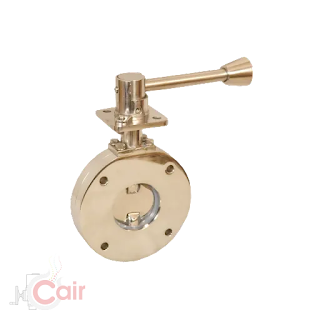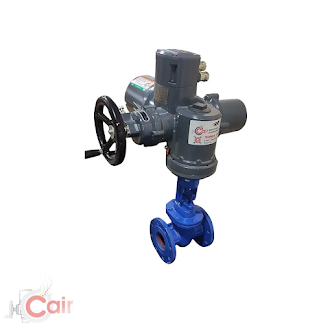How Butterfly Valves Work: A Comprehensive Guide
If you've ever wondered how those big, round valves work that is often used in water lines and other types of piping, you're in luck. This blog post will give you a comprehensive guide to butterfly valves, including how they work and the different types that exist. You'll also learn about the advantages and disadvantages of butterfly valves so that you can decide if they're the right choice for your needs.
Introduction
A butterfly valve is a quarter-turn valve that regulates the flow of liquids and gases by opening, closing, or partially obstructing a passageway. Butterfly valves are named for their disc-shaped bodies and wing-like handles.
Butterfly valves are often used in systems that require a frequent operation, such as in HVAC (heating, ventilation, and air conditioning) systems. They are also well suited for applications where space is limited, as they are much smaller and lighter than other types of valves.
There are two main types of butterfly valves: lug-type and wafer-type. Lug-type butterfly valves have protruding lugs on the body that allows for the installation of a pipe or rod to actuate the valve. Wafer-type butterfly valves have a flat body with no lugs, so they must be installed between two flanges.
Butterfly valves can be made from a variety of materials, including metal (such as steel or brass), plastic (such as PVC or ABS), or rubber (such as EPDM). The choice of material depends on the application and the compatibility of the fluid with the material.
Butterfly valves are simple in design and easy to operate, making them a popular choice for many applications.
What are Butterfly Valves?
Butterfly valves are a type of quarter-turn valve that is used to control the flow of liquids and gases. They are named after their shape, which is similar to that of a butterfly's wings. Butterfly valves are widely used in many industries because they are very versatile and can be used for both low-pressure and high-pressure applications.
There are two main types of butterfly valves: wafer butterfly valves and lug butterfly valves. Wafer butterfly valves have a flat disc with two holes in it, while lug butterfly valves have a disc with four lugs (ears) that protrude from the body of the valve.
Butterfly valves are easy to operate and maintain, and they can be installed in either horizontal or vertical pipelines.
How do Butterfly Valves Work?
Butterfly valves get their name from their shape. The round disc is reminiscent of a butterfly's wings, and the two handles on the side look like a butterfly's body. When the valve is open, the disc is flat and parallel to the pipeline. When the valve is closed, the disc is perpendicular to the pipeline, and the handles are in line with the disc. Butterfly valves can be installed in either horizontal or vertical pipelines.
Butterfly valves are easy to operate. To open the valve, you simply turn the handle so that it is perpendicular to the pipeline. This opens up a gap between the two halves of the disc, allowing fluid to flow through. To close the valve, you turn the handle so that it is parallel to the pipeline. This aligns the two halves of the disc, creating a seal that prevents fluid from flowing through. Butterfly valves are also easy to maintain. Because they have few moving parts, there are fewer opportunities for something to go wrong. And if something does go wrong, butterfly valves are relatively easy to repair.
There are two main types of butterfly valves: wafer butterfly valves and lug butterfly valves. Wafer butterfly valves have a circular disk that fits snugly inside the pipe. Lug butterfly valves have a disk with lugs on either side that extend outside of the pipe. Both types of valves work in basically the same way. But lug butterfly valves are more robust and can handle higher pressures than wafer butterfly valves.
Butterfly valves are a type of quarter-turn valve used to control flow by turning a knob at 90 degrees. They usually come in two different types which include wafer or lug-style designs and can be installed in both horizontal or vertical positions. The name “butterfly” comes from its shape which resembles that of a flying insect’s wings. When closed, it looks like two semicircles put together at an angle while when open, it appears as if these semicircles were opened up sideways revealing a hole in between them big enough for liquid or gas to pass through. There are not many moving parts involved in its function which makes it easier to operate as well as maintain over time. In addition, should anything go wrong with this type of valve, repairs tend not to be as costly compared to other types.
Types of Butterfly Valves
There are two main types of butterfly valves: wafer butterfly valves and lug butterfly valves.
Wafer butterfly valves have a circular disk that fits snugly inside the pipe. The disk is connected to a rod that goes through the center of the valve. When the rod is turned, the disk opens or closes, depending on which way the rod is turned. Wafer butterfly valves are often used in applications where a tight seal is required, such as in food processing or pharmaceutical manufacturing.
Lug butterfly valves have a disk with lugs on either side that extend outside of the pipe. The lugs are connected to a rod that goes through the center of the valve. When the rod is turned, the disk opens or closes, depending on which way the rod is turned. Lug butterfly valves are often used in applications where a quick and easy operation is required, such as in water treatment plants.
Advantages of Butterfly Valves
Butterfly valves offer several advantages over other types of valves, making them well-suited for a wide range of applications. One of the main advantages of butterfly valves is their compact design. Butterfly valves are also much lighter than other types of valves, making them easier to install and operate. Another advantage of butterfly valves is that they can be installed in either horizontal or vertical pipelines.
Butterfly valves are also very easy to operate and maintain. The disk in a butterfly valve is connected to a shaft, which is turned to open or close the valve. When the disk is turned to the open position, it allows fluid to flow through the valve. When the disk is turned to the closed position, it blocks the flow of fluid. Butterfly valves can be operated manually or with an automated system.
Disadvantages of Butterfly Valves
Butterfly valves also have a few disadvantages. One is that they are not well suited for very high-pressure applications. Another is that because the disk is located in the center of the pipe, the butterfly valve takes up more space than other types of valves. Finally, butterfly valves are not as widely used as other types of valves, so they may be more difficult to find and purchase.
Cair Euromatic Automation is the leading butterfly valve manufacturer in India. We offer various types of industrial valves like ball valves, butterfly valves, control valves, and many more.



Comments
Post a Comment